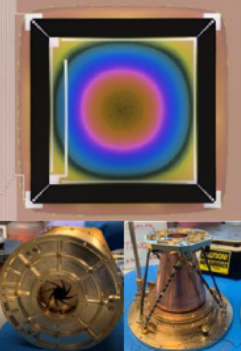
Jake Connors
Physicist
Education
- Ph.D. (2018) • Physics • Harvard University
- M.Sc. (2013) • Physics • Harvard University
- BSc. (2011) • Physics • Ohio State University
Current Position
- Physicist, NASA Goddard Space Flight Center, Greenbelt, MD
- Development of novel technologies in the application of cryogenic detectors for the ultra-sensitive detection of microwave through Far-IR radiation

At the top of the image is a top-down view of a transition edge sensor bolometer design for use in the Far-Infrared. The bolometer uses novel phononic filtering to reduce the fundamental noise of the detector. At the bottom of the image are views of a cryogenic variable-temperature blackbody calibrator, used to illuminate and measure the optical efficiency of bolometric detectors. Both the blackbody calibrator and detector are operated below 0.1K, just barely above absolute zero temperature.
Technology Interests
- Ultra-low noise cryogenic detectors for astrophysics
- Techniques for compact sub-mm/FIR spectroscopy
- Materials metrology for microwave thru FIR optical elements, substrates and absorbers
- Applications of photonic and phononic structures to detector and microwave system design
- Leveraging advances in Quantum Computing for constructing novel astronomical detectors
- Deployment of these technologies aboard sub-orbital and orbital platforms for astrophysics
Goals and Aspirations
- Enabling future FIR astrophysics through the development of ultra-low noise detectors and high-resolving power dispersive optical elements
- Building a well-rounded research group where I can mentor young scientists and help build the next generation of astrophysicists
- Broaden my own knowledge and experience to better recognize and study disruptive technologies within astrophysics and related fields
- Lead FIR astrophysics forward as a community through the IR-STIG and enable young scientists from diverse backgrounds to meaningfully contribute to and steer the future of the field


























